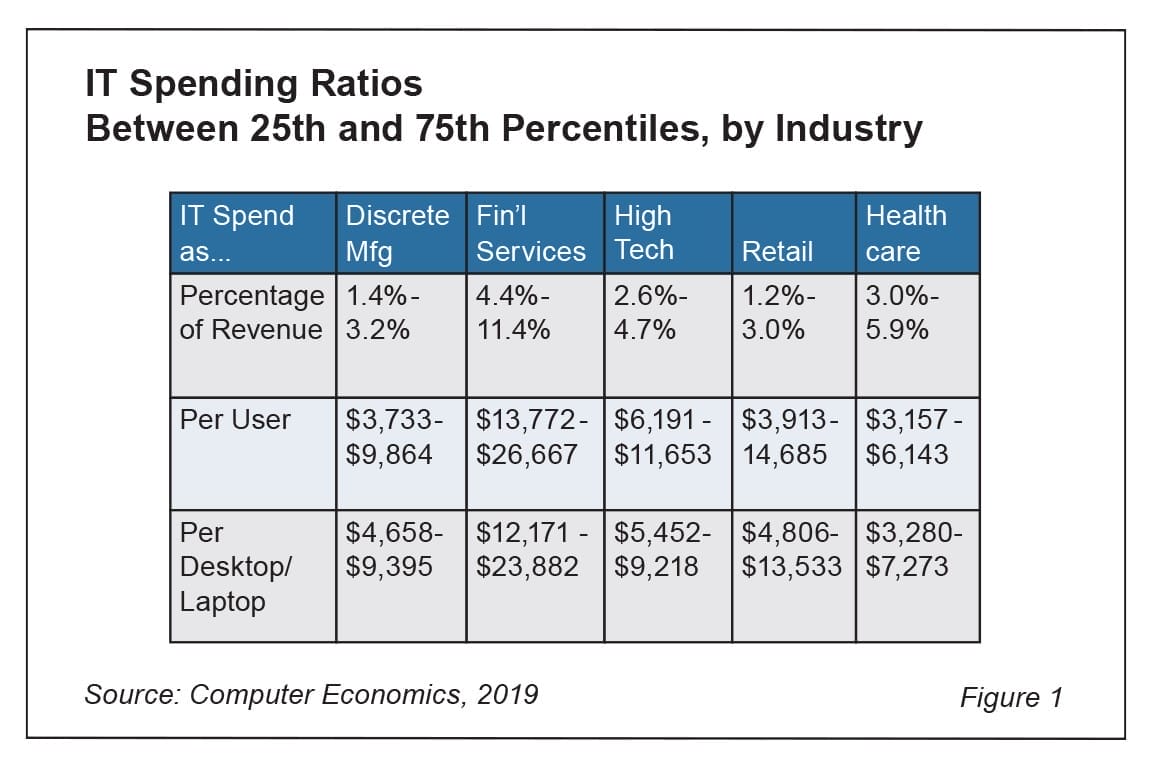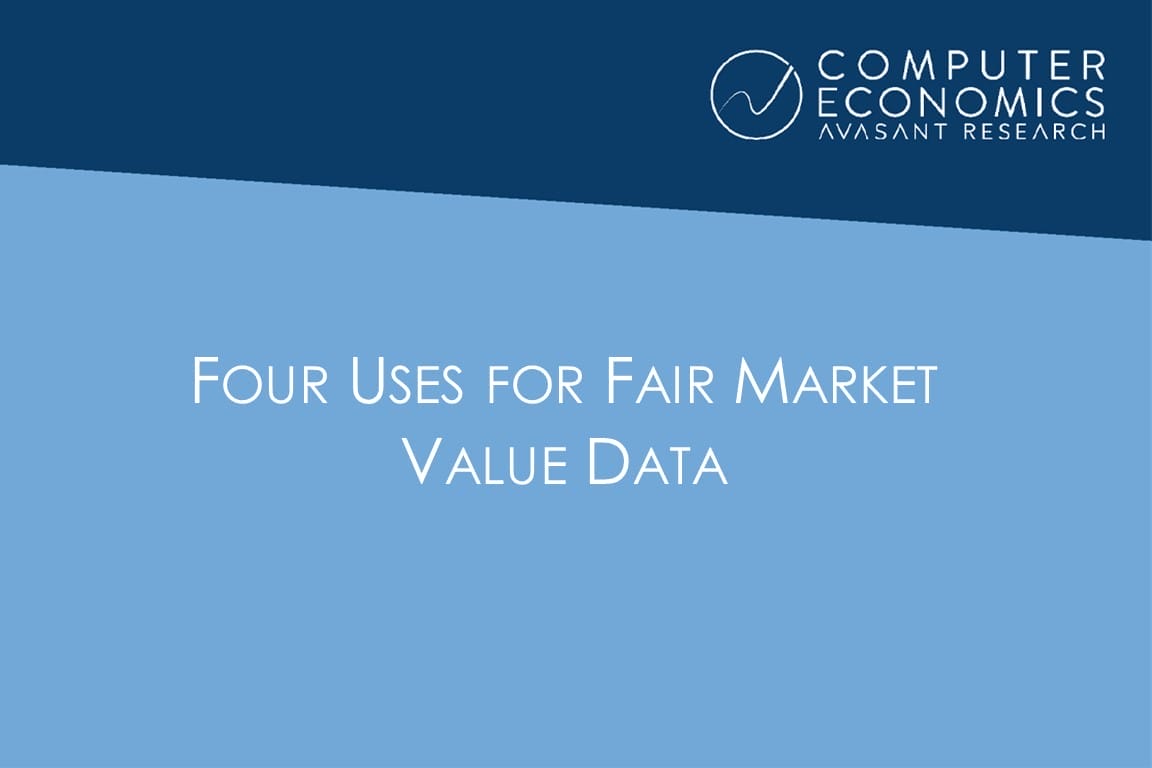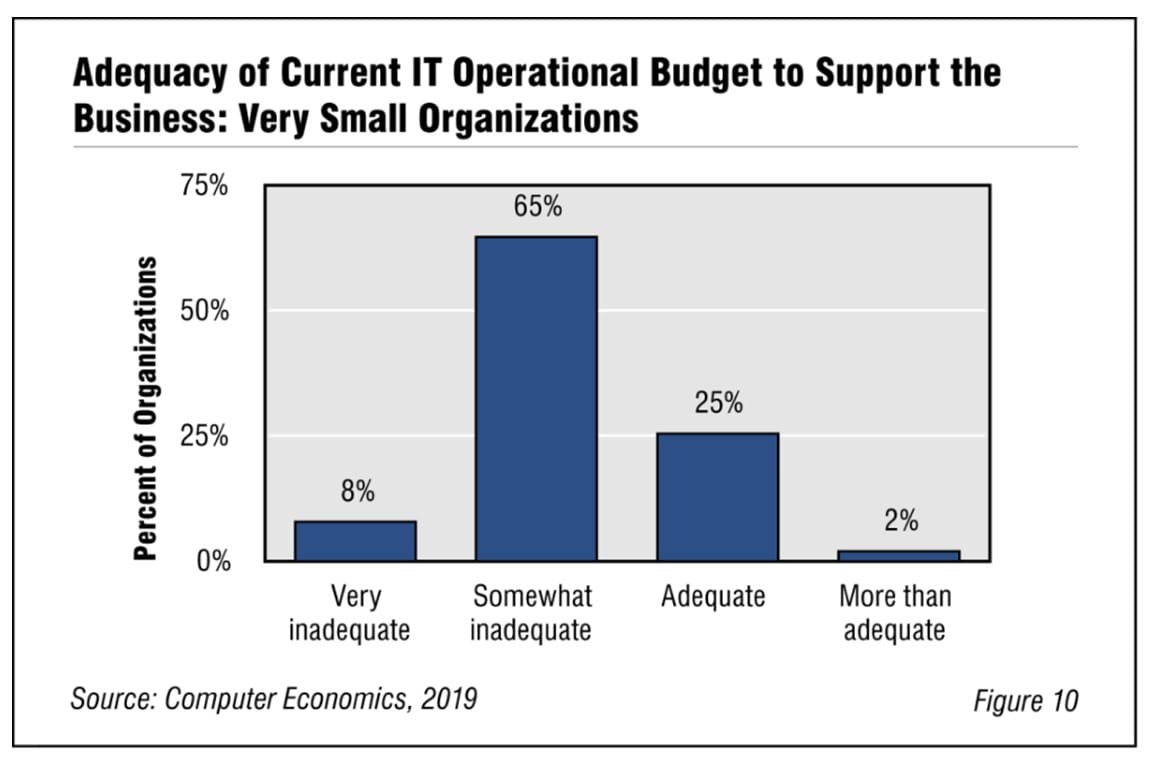Latest Reports
-
![IT Spending as a Percentage of Revenue by Industry, Company Size, and Region Fig1IT Spending as a Percentage of Revenue - IT Spending as a Percentage of Revenue by Industry, Company Size, and Region]()
IT Spending as a Percentage of Revenue by Industry, Company Size, and Region
This Research Byte analyzes IT spending as a percentage by industry, IT costs as a percentage of revenue by company size, and IT budgets as a percentage of revenue by region. We discuss why it is better to evaluate percentiles rather than average IT spending. Finally, we outline other key metrics for IT budget analysis, such as IT spending per employee, IT spending per user, and IT spending per desktop.
January, 2021
-
![Four Uses for Fair Market Value Data FourUsesFMVdata - Four Uses for Fair Market Value Data]()
Four Uses for Fair Market Value Data
Any company that invests in information technology has an ongoing need for fair market values (FMV) of IT equipment. Although executives readily see the usefulness of FMV data when they buy or sell used equipment, in fact there are three other reasons that accurate FMV data is essential to a well-managed IT function. When considered together, these four reasons suggest that IT organizations would do well to ensure that FMV data is readily available.
January, 2019
-
![Choosing Between Solid State Drives and Hard Disk Drives When Upgrading PCs, Laptops DiskDrives - Choosing Between Solid State Drives and Hard Disk Drives When Upgrading PCs, Laptops]()
Choosing Between Solid State Drives and Hard Disk Drives When Upgrading PCs, Laptops
When upgrading PCs or laptops, the choice of hard drive is a critical decision. Traditional hard drives (HDD) and newer solid-state drives (SSD) have different characteristics in terms of cost, performance, reliability, and useful life, which should influence the decision. This report provides an overview of the two types of drives and provides criteria for making the right choice.
November, 2018
-
![Understanding Fair Market and Residual Values in Negotiating Leasing Options FMVfig1 - Understanding Fair Market and Residual Values in Negotiating Leasing Options]()
Understanding Fair Market and Residual Values in Negotiating Leasing Options
The terms “fair market value” and “residual value” have different meanings, and it is important to know the difference when buying or leasing PCs, laptops, and other equipment. In addition, those who hold the leases (lessees) and leasing companies (lessors) use different methodologies to create their own definitions. This article outlines the perspectives of lessees and lessors, and how the former benefits from negotiating lease contracts in a considered way.
March, 2019
-
![How to Plan for New Desktop Equipment Acquisitions NewDesktopEquipment - How to Plan for New Desktop Equipment Acquisitions]()
How to Plan for New Desktop Equipment Acquisitions
There are many complex decisions that must be made during the PC procurement process—especially in cases where there are several thousand units involved. This report examines the various decisions required in this process, explores the pros and cons of purchase versus lease, and provides an outline to ensure that the final contract will deliver sound economics and flexibility for your organization.
January, 2019
-
![Very Small Organizations Struggling for IT Budget Fig1VerysmallOrgRB - Very Small Organizations Struggling for IT Budget]()
Very Small Organizations Struggling for IT Budget
For the first time, Computer Economics has conducted a study on the IT spending habits of organizations in the U.S. and Canada that are too small to qualify for our annual benchmarks survey. We decided to examine the IT spending habits of these “very small organizations” with a dedicated survey to determine their spending habits and priorities, and to provide some metrics that can be used to benchmark their spending. This Research Byte provides a summary and description of our full report on IT spending and staffing in very small organizations.
November, 2019
-
![IT Spending Benchmarks for Very Small Organizations 2019-2020 Fig1VerysmallOrgRB - IT Spending Benchmarks for Very Small Organizations 2019-2020]()
IT Spending Benchmarks for Very Small Organizations 2019-2020
For the first time, Computer Economics has conducted a study on the IT spending habits of “very small” organizations in the U.S. and Canada, a population that is beneath the size threshold for our annual IT spending and staffing benchmark study. This report examines high-level IT spending, staffing metrics and trends for such very small IT organizations. We further break down the high-level metrics by three sectors: manufacturing, retail and wholesale distribution; professional and technical services; and financial services. To qualify as very small for the purposes of this study, a company has to be either under $50 million in revenue or under $1 million in IT operational spending. (36 pp., 17 fig.)
November, 2019
-
![Worldwide IT Spending and Staffing Outlook for 2020 Fig1WorldwideITSpendingandStaffingOutlookfor2020 - Worldwide IT Spending and Staffing Outlook for 2020]()
Worldwide IT Spending and Staffing Outlook for 2020
Although IT leaders worldwide have a positive outlook for the global economy, that outlook seems a bit tinged with frustration compared to previous years. This report, based on our Q4 survey, provides data on the global and U.S./Canadian trends for IT spending and staffing in 2020. This year, our report assesses IT operational and capital spending plans, executive priorities for IT investment, and plans for hiring, outsourcing, and pay raises for IT organizations worldwide and in the U.S. and Canada. (34 pp., 24 fig.)
January, 2020
-
![IT Leaders on Edge as Budgets Continue Only Modest Gains Fig1WorldwideITSpendingandStaffingOutlookfor2020 - IT Leaders on Edge as Budgets Continue Only Modest Gains]()
IT Leaders on Edge as Budgets Continue Only Modest Gains
Here at the end of 2019, we find that IT leaders worldwide have a positive outlook for the global economy. Nevertheless, hat outlook is tinged with frustration compared to previous years. It is not exactly that leaders fear a recession (though an increasing number do) so much as they are becoming fed up with years of modest increases and not-so-modestly increasing demands for service. This research byte summarizes the full report, Worldwide IT Spending and Staffing Outlook for 2020.
January, 2020
-
![Employee Centricity and Customer Experience Takes The Forefront covid 19 conceptual - Employee Centricity and Customer Experience Takes The Forefront]()
Employee Centricity and Customer Experience Takes The Forefront
COVID-19 has brought focus back on collaboration, automation, and security, however this time it centers around employee engagement and customer experience. Owing to the pandemic, there is sudden change in people’s habits and preferences, specifically the way they operate and interact as they embrace work-from-home culture. Progressive enterprises are adopting a “cloud-first” strategy and looking for newer digital ways of working and serving their customers. Zensar, being cognizant of this trend, has already identified and laid out a digital enterprise priority, hinged around enabling experience, business agility, and automation.
October, 2020
-
![Amid Changes, Communications Support Staff Increases Fig1CommunicationSupport2019 - Amid Changes, Communications Support Staff Increases]()
Amid Changes, Communications Support Staff Increases
Corporate communications systems have become more sophisticated in recent years. As a result, it is becoming more difficult to determine how to staff the role of supporting them. As such, the size of the communications system support staff as a percentage of the IT staff has been prone to large fluctuations in recent years. This Research Byte provides a summary of our full report on communications support staffing ratios.
January, 2019
-
![Covid-19 Pandemic Boosting Demand for Web/E-commerce Personnel Fig1WebEcommerce2020 - Covid-19 Pandemic Boosting Demand for Web/E-commerce Personnel]()
Covid-19 Pandemic Boosting Demand for Web/E-commerce Personnel
Web/e-commerce support personnel have been increasing as a share of the typical IT staff over the past five years. And now, as a result of the COVID-19 pandemic, this IT staff position is getting a big boost as organizations are having to increase their digital interactions with customers, partners, and suppliers.This Research Byte summarizes the five-year trend in web/e-commerce staffing ratios.
April, 2020

















